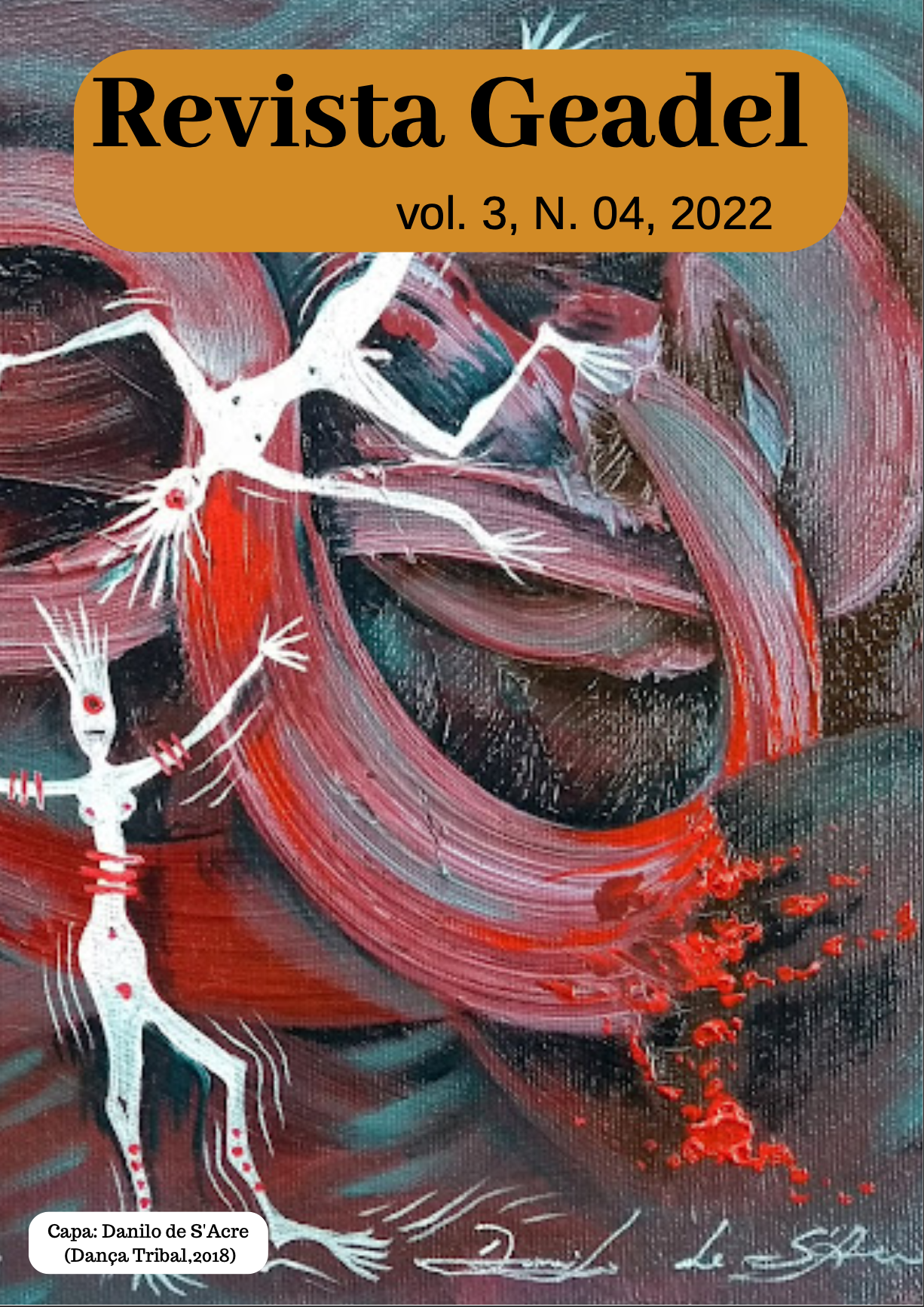A CONSCIÊNCIA FONOLÓGICA NO PROCESSO DE AQUISIÇÃO DA L2 SOB AS LENTES DA SOCIOLINGUÍSTICA VARIACIONISTA
DOI:
https://doi.org/10.29327/269116.3.4-7Palavras-chave:
Consciência Fonológica. Fricativa interdental não vozeada. Ensino de Inglês (L2). Sociolinguística Variacionista.Resumo
O presente trabalho se propôs a investigar a importância da consciência fonológica para a concretização do processo de aquisição de uma segunda língua (L2), sob os parâmetros da Sociolinguística Variacionista. Recorreu-se aos pressupostos teórico-metodológicos da Sociolinguística Variacionista, formulada por Labov (2008 [1972]), bem como da Aquisição de L2 e na Teoria Acústica de produção da fala. Um dos resultados desse trabalho foi que a interface entre a Sociolinguística e a Aquisição de L2 trouxe ricas contribuições para o entendimento dos fatores que regulam o processamento linguístico no falante aprendiz, visto que, pesquisas anteriores a esta interface, como as de Beebe (1977), Selinker & Douglas (1985), Tarone (1985) e Ellis (1987), levavam em conta condicionadores isolados para as variações existentes na fala dos interlocutores. Constatou-se que as contribuições da consciência fonológica constituem fator imprescindível para a produção de segmentos não comuns ao sistema linguístico do aprendiz brasileiro de inglês (L2).
Downloads
Referências
ADAMSON, Douglas., & REGAN, Vera. The acquisition of community speech norms by asian immigrants learning English as a second language: a preliminary study. Studies in Second Language Acquisition, 1991.
AKAMATSU, Nobuhiko. A similarity in word-recognition procedures among second language readers with diferente first language background. Aplied psycholinguistics, v. 23, p. 117-133, 2002.
ALVES, Anilda Costa. A importância da consciência fonológica na aquisição do inglês como segunda língua. Universidade Estadual da Paraíba: UEPB. Guarabira, 2016.
ALVES, Ubiratã Kickhofel. Consciência dos aspectos fonético-fonológicos da L2. In: Consciência dos Sons da Língua: subsídios teóricos e práticos para alfabetizadores, fonoaudiólogos e professores da língua inglesa/org. Regina Ritter Lamprecht; Ana Paula Blanco-Dutra...[et al.].- 2. Ed. Porto Alegre: EDIPUCRS, 2012.
ALVES, Ubiratã Kickhofel; ZIMMER, Márcia Cristina. Perceber, notar e aprender: uma visão conexionista da consciência do aprendiz na aquisição fonológica da L2. Revista Virtual de Estudos da Linguagem – ReVEL, ano 3, n. 5, 2005a.
BARBOSA, Plínio.; MADUREIRA, Sandra. Manual de fonética acústica experimental – Dados aplicados ao português brasileiro. São Paulo, Cortez Editora, 2015.
BAYLEY, Robert. Second language acquisition and sociolinguistic variation. Intercultural Communication Studies. XIV. 2, 2007.
BEEBE, Leslie. The influence of the listener on code-switching. Language Learning, 1977.
BEST, Catherine.; McROBERTS, Gerald.; GOODELL, Elizabeth. Discrimination of non-native contrasts varying in perceptual assimilation to the listener’s native phonological system. Journal of the Acoustical Society of America, v. 109, n. 2, p. 775-794, Feb. 2001.
BOERSMA, Paul.; WEENINK, David. Praat: doing phonetics by computer (Version 5.3) Retrieved from: http//www.praat.org, 2014.
CHARD, David.; DICKSON, Shirley. Phonological Awareness: Instructional and Assessment Guidelines. Intervention in School and clinic.v. 34, n. 5, p. 261-70, 1999.
CHIBA, Tsutomu.; KAJIYAMA, Masato. The vowel: its nature and structure. Tokyo: Tokyo-Kaiseikan, 1941.
COELHO, Izete Lehmkuhl.; [et al.]. Para conhecer Sociolinguística. São Paulo: Contexto, 2015.
DeKEYSER, Robert. Beyond explicit rule learning: automatizing second language morphosyntax. Studies in Second Language Acquisition, v. 19, p. 195-221, June 1997.
ELLIS, Rod. The structural syllabus and second language acquisition. TESOL Quartely, v. 24, n. 1, p. 91-113, 1993.
ELLIS, Rod. The study of Second Language Acquisition. Oxford: Oxford University Press, 1997.
FANT, Gunnar. Acoustic theory of speech production. With calculations based on X-ray studies of Russian articulations. Haia: Mouton, 1960.
FLEGE, James.Emil. Assessing constraints on second-language segmental production and perception. In: MEYER, A.; SCHILLER, N. Phonetics and phonology in language comprehension and production: differences and similarities. Berlin: Mouton, 2003.
JENKINS, Jennifer. The phonology of English as an international language: new models, new norms, new goals. Oxford University Press, 2000.
KENT, Raymond; READ, Charles. The acoustic analysis of speech. 2nd edition. New York: Delmar, Cengage Learning, 2002.
KRASHEN, Stephen. Second language acquisition and second language learning. London: Pergamon Press, 1981.
KUHL, Patricia. A new view of language acquisition. Proceedings of the national academy of Science, n. 97, p. 11850-11857, 2000.
KUHL, Patricia; IVERSON Paul. “Linguistic experience and the “perceptual magnet effect”. In: STRANGE, W. Speech perception and linguistic experience: issues in cross-language research. Baltimore: York Press, 1995.
LABOV, William. Padrões Sociolinguísticos. Tradução de Marcos Bagno; Mª Marta Pereira Scherre & Caroline Rodrigues Cardoso. São Paulo: Parábola Editorial, 2008 [1972].
LADEFOGED, Peter; JOHNSON, Keith. A Course in Phonetics 6th ed. Boston, Wadsworth. 2011.
MOREIRA, Leandro Pimental Rodrigues. A percepção da fricativa interdental surda do inglês (L2) por falantes nativos do português. Dissertação de Mestrado. Pelotas: UCPEL, 2015.
PELEIAS, Fabiola D’Agostini. A produção e a percepção da fricativa interdental surda por aprendizes brasileiros de língua inglesa. Dissertação de mestrado em Linguística. São Paulo: PUCSP, 2009.
RUHMKE-RAMOS, Nadia Karina; DELATORRE Fernanda. The effects of training and instruction on the perception of the English interdental fricatives by Brazilian EFL learners. Universidade Federal de Santa Catarina, 2011.
REIS, Mara Silva. The perception and production of english interdental fricatives by Brazilian EFL learners. Dissertação de mestrado em Linguística. Santa Catarina: UFSC, 2006.
SCHADECH, Thaís Suzana.; SILVEIRA, Rosane. How do the non-target pronunciations of the consonants /θ/ and /ð/ by Brazilian learners of English affect comprehensibility? Cadernos do IL. Porto Alegre, n. 46, junho de 2013.
SCHMIDIT, Richard. The role of consciousness in second language learning. Applied Linguistics, v. 11, p, 129-158, 1990.
SELINKER, Larry.; DOUGLAS, Dan. Wrestling with contexto in interlanguage theory. Applied Linguistics 6: 67-92, 1985.
TARONE, Elaine. Variability in interlanguage use: a study of style-shifting in: Morphology and syntax. Language learning 35: 373-404, 1985.
WILDE, Lorin. Analysis and synthesis of fricative consonants. PhD thesis, Department of Electrical Engineering and Computer Science, Massachusetts Institute of Technology, Cambridge, U.S.A, 1995.
YOUNG, Richard; ROBERT, Bayley. VARBRUL analysis for second language acquisition research. In Robert Bayley and Dennis R. Preston, eds. Second language acquisition and linguistic variation (pp, 253-306). Amsterdam: John Benjamin. 1996.
Downloads
Publicado
Como Citar
Edição
Seção
Licença
Copyright (c) 2022 Revista Geadel

Este trabalho está licenciado sob uma licença Creative Commons Attribution-NonCommercial 4.0 International License.
Os autores concedem à revista todos os direitos autorais referentes aos trabalhos publicados. Os conceitos emitidos em artigos assinados são de absoluta e exclusiva responsabilidade de seus autores.





